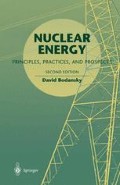Abstract
Nuclear reactors are now being used in 31 countries for the generation of electricity. Overall, they supply about one-sixth of the world’s electricity [1]. As of November 2003, there were 440 operating nuclear power reactors in the world, with a combined net generating capacity of 360 gigawatts-electric (GWe) [2].1 Summary data on these reactors are presented in Table 2.1, which lists for each country the total nuclear generation and nuclear power’s fraction of the total electricity generation.
We here use data compiled by the International Atomic Energy Agency (IAEA) and posted, with periodic updating, on its website [2, 3].
Access this chapter
Tax calculation will be finalised at checkout
Purchases are for personal use only
Preview
Unable to display preview. Download preview PDF.
References
U.S. Department of Energy, International Energy Annual 2001, Energy Information Administration report DOE/EIA-0219 (2001) (Washington, DC: U.S. DOE, March 2003).
International Atomic Energy Agency, “Nuclear Power Plants Information: Operational & Under Construction Reactors by Country” (updated 11/17/03). [From: http://www.iaea.org/cgi-bin/db.page.pl/pris.reaopucct.htm]
International Atomic Energy Agency, Nuclear Power Reactors in the World, Reference Data Series No. 2, April 2003 edition (Vienna: IAEA, 2003).
“World List of Nuclear Power Plants,” Nuclear News 46, no. 3, March 2003: 41–67.
Ernest Rutherford, “Radioactivity,” in The Encyclopaedia Britannica, 11th edition, Vol. 22, (New York: The Encyclopedia Britannica Company, 1910): 802.
Charles Weiner, “1932—Moving into the New Physics,” in History of Physics, Spencer R. Weart and M. Phillips, eds. (New York: American Institute of Physics, 1985).
Emilio Segrè, From X-rays to Quarks: Modern Physicists and Their Discoveries (San Francisco: W.H. Freeman, 1980).
Richard Rhodes, The Making of the Atomic Bomb (New York: Simon and Schuster, 1986).
Leo Szilard: His Version of the Facts, Spencer R. Weart and Gertrud Weiss Szilard, eds. (Cambridge: MIT Press, 1978).
Bertrand Goldschmidt, Atomic Rivals, translated by George M. Temmer (New Brunswick: Rutgers University Press, 1990).
Samuel Glasstone, Sourcebook on Atomic Energy (New York: Van Nostrand, 1950).
Henry D. Smyth, Atomic Energy for Military Purposes (Princeton, NJ: Princeton University Press, 1945).
A.M. Weinberg to R.L. Doan, memorandum, September 18, 1944, in Alvin M. Weinberg, The First Nuclear Era: The Life and Times of a Technological Fixer (New York: American Institute of Physics Press, 1994).
Richard G. Hewlett and Jack M. Holl, Atoms for Peace and War: 1953–1961 (Berkeley: University of California Press, 1989).
“What Is the Atom’s Industrial Future,” Business Week, March 8, 1947, pp. 21–22, as cited in The American Atom, Robert C. Williams and Philip L. Cantelon, eds. (Philadelphia: University of Pennsylvania Press, 1984): 97–104.
Atomic Industrial Forum, “Too Cheap to Meter?” Anatomy of a Cliché, Special Report (1980).
Nuclear Energy Institute, Historical Profile of U.S. Nuclear Power Development, 1994 edition, (Washington, DC: NEI, 1994).
U.S. Department of Energy, Annual Energy Review 2001, Energy Information Administration report DOE/EIA-0384(2001) (Washington, DC: U.S. DOE, November 2002).
“Browns Ferry: Unit 1 Restart on Schedule, Budget,” Nuclear News 46, no. 4, April 2003: 20.
U.S. Department of Energy, Monthly Energy Review, March 2003, Energy Information Administration report DOE/EIA-0035(2003/03) (Washington, DC: U.S. DOE, April 2003).
The President’s Committee of Advisors on Science and Technology, Federal Energy Research and Development for the Challenges of the Twenty-First Century (Washington, DC: Executive Office of the President, November 1997).
U.S. Department of Energy, Monthly Energy Review, August 2003, Energy Information Administration Report DOE/EIA-0035(2003/08) (Washington, DC: U.S. DOE, 2003).
Nuclear Energy Institute, “U.S. Nuclear Power Plants Top 75-Percent Capacity,” Nuclear Energy Insight, March 1995: 8.
“World List of Nuclear Power Plants,” Nuclear News 41, no. 3, March 1998: 39–54.
Nuclear Energy Institute, Fact Sheet: Nuclear Plant License Renewal, February 2002. [From: http://www.nei.org/doc.asp?catnum=3&catid=615]
Energy, U.S. Code of Federal Regulations, title 10.
“Status of license renewal applications in the United States,” Nuclear News 46, no. 12, November 2003: 24.
A.M. Petrosyants, From Scientific Search to Atomic Industry, translated from the 1972 Russian edition (Danville, IL: The Interstate Printers & Publishers, 1975).
International Atomic Energy Agency, Energy, Electricity and Nuclear Power Estimates for the Period up to 2020, Reference Data Series No. 1 (Vienna: IAEA, 2002).
U.S. Department of Energy, International Energy Outlook 2002, Energy Information Administration Report DOE/EIA-0484(2002) (Washington, DC: U.S. DOE, 2002).
Organization for Economic Co-operation and Development, Nuclear Energy Agency, Nuclear Energy Data 2001 (Paris: OECD, 2001).
“World List of Nuclear Power Plants,” Nuclear News 36, no. 3, March 1993: 41–60.
International Energy Agency, Russia Energy Survey 2002 (Paris: OECD/IEA, 2002).
International Energy Agency, Nuclear Power in the OECD (Paris: OECD/IEA, 2001).
U.S. Atomic Energy Commission, Nuclear Power 1973–2000, Report Wash-1139(72) (Washington, DC: AEC, 1972).
Rights and permissions
Copyright information
© 2004 Springer-Verlag New York, LLC
About this chapter
Cite this chapter
(2004). Nuclear Power Development. In: Nuclear Energy. Springer, New York, NY. https://doi.org/10.1007/0-387-26931-2_2
Download citation
DOI: https://doi.org/10.1007/0-387-26931-2_2
Publisher Name: Springer, New York, NY
Print ISBN: 978-0-387-20778-0
Online ISBN: 978-0-387-26931-3
eBook Packages: Physics and AstronomyPhysics and Astronomy (R0)

